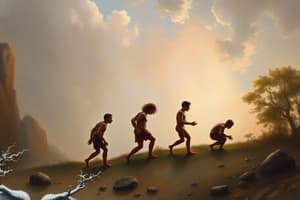Podcast
Questions and Answers
Which concept, proposed by Lamarck, suggests that organisms can change during their lifetime by using or not using certain body parts and passing those changes to their offspring?
Which concept, proposed by Lamarck, suggests that organisms can change during their lifetime by using or not using certain body parts and passing those changes to their offspring?
- Survival of the Fittest
- Acquired Traits (correct)
- Genetic Mutation
- Natural Selection
Which of the following best describes the role of mutations in the context of evolution?
Which of the following best describes the role of mutations in the context of evolution?
- Mutations always lead to an organism's extinction.
- Mutations can be either favorable or unfavorable. (correct)
- Mutations have no impact on an organism's survival.
- Mutations are always favorable for survival.
What is the significance of homologous structures in different species?
What is the significance of homologous structures in different species?
- They indicate a recent common ancestor.
- They indicate adaptation to similar environments, but not necessarily a shared ancestry.
- They serve the exact same function in all species.
- They suggest adaptation to different environments from a common ancestor. (correct)
How does the fossil record provide evidence for evolution?
How does the fossil record provide evidence for evolution?
What does the term 'fitness' refer to in the context of natural selection?
What does the term 'fitness' refer to in the context of natural selection?
Which of the following is an example of biogeography influencing the evolution of species?
Which of the following is an example of biogeography influencing the evolution of species?
How do embryological similarities among different species provide evidence for evolution?
How do embryological similarities among different species provide evidence for evolution?
What is the significance of vestigial structures in the study of evolution?
What is the significance of vestigial structures in the study of evolution?
In the context of evolution, what does 'adaptation' refer to?
In the context of evolution, what does 'adaptation' refer to?
How does radiometric dating contribute to our understanding of evolution?
How does radiometric dating contribute to our understanding of evolution?
What is the primary difference between homologous and analogous structures?
What is the primary difference between homologous and analogous structures?
Which of the following is the most accurate definition of 'evolution'?
Which of the following is the most accurate definition of 'evolution'?
Why is the concept of 'common ancestry' important in evolutionary biology?
Why is the concept of 'common ancestry' important in evolutionary biology?
What role does competition play in natural selection?
What role does competition play in natural selection?
What is the relationship between DNA similarity and the relatedness of different species?
What is the relationship between DNA similarity and the relatedness of different species?
Which dating method is considered an absolute dating technique?
Which dating method is considered an absolute dating technique?
What does 'survival of the fittest' actually mean in evolutionary terms?
What does 'survival of the fittest' actually mean in evolutionary terms?
An organism that exhibits mimicry is demonstrating what?
An organism that exhibits mimicry is demonstrating what?
Which of the following directly contributes to genetic variation within a population?
Which of the following directly contributes to genetic variation within a population?
Flashcards
Evolution
Evolution
Process by which organisms change over time due to heritable physical or behavioral traits.
Theory
Theory
A well-substantiated explanation of the natural world, confirmed through observation and experimentation.
Acquired Traits
Acquired Traits
Traits acquired during an organism's lifetime are passed on to its offspring (incorrect).
Natural Selection
Natural Selection
Signup and view all the flashcards
Survival of the Fittest
Survival of the Fittest
Signup and view all the flashcards
Fitness
Fitness
Signup and view all the flashcards
Adaptations
Adaptations
Signup and view all the flashcards
Relative vs. Absolute Dating
Relative vs. Absolute Dating
Signup and view all the flashcards
Fossils
Fossils
Signup and view all the flashcards
Homologous Structures
Homologous Structures
Signup and view all the flashcards
Analogous Structures
Analogous Structures
Signup and view all the flashcards
Vestigial Structures
Vestigial Structures
Signup and view all the flashcards
Mutations
Mutations
Signup and view all the flashcards
Embryology
Embryology
Signup and view all the flashcards
Biogeography
Biogeography
Signup and view all the flashcards
Study Notes
- Evolution is the process by which organisms change over time
- These changes occur due to heritable physical or behavioral traits
- A theory is a well-substantiated explanation of some aspect of the natural world
- Theories are based on facts repeatedly confirmed through observation and experimentation
Lamarck's Ideas
- Acquired traits refers to traits gained during an organism’s lifetime
- Use it or lose it suggests that traits used are kept, while unused traits are lost
- Organisms wanted to change, implying a conscious effort to evolve
Darwin's Variations
- Galapagos Islands are a key location in understanding evolutionary variations
- Natural Selection leads to the survival of the fittest
- Limited resources drive competition
- All organisms come from common ancestors
Key Notes on Evolution
- Organisms within a species differ from each other
- More offspring are produced than can survive
- The best adapted to the environment survives
- Organisms compete for resources
- Modern organisms has a common ancestor
Vocabulary
- Struggle for existence is the competition among organisms to survive
- Variations are differences within a species
- Favorable traits are passed on through genetics
- Mimicry is when one organism copies another
- Survival of the fittest means the best suited to the environment will survive
Fossils
- Fossils are remains of living things
- Fossils are found in sedimentary rock
- Isotopes are used in dating fossils
- Relative dating estimates a fossil’s age based on its position in rock layers
- Radiometric (Absolute) dating uses the half-life of Carbon-14 for accurate dating
Anatomy
- Bodily structures adapt for different purposes
- Modifications occur from ancestors
- Homologous structures have similar structures but different functions
- Analogous structures have similar functions but a different structure
- Vestigial structures have lost most or all of their original function
Chemistry/Chemical
- More similar DNA indicates a closer evolutionary relationship
- Mutations can be favorable or unfavorable
- DNA/RNA carries genetic information
- The universal genetic code is shared by all organisms
Embryology
- Embryos show similar patterns of early development
- Organisms descend from a common ancestor
- The development stages are similar to trimesters
- Vertebrates have backbones
Biogeography
- Closely related organisms live in different habitats
- Distantly related organisms may have similar habitats and adaptations
- Environment influences adaptation
- Camouflage is a survival adaptation
- Migration is movement to a new environment
Studying That Suits You
Use AI to generate personalized quizzes and flashcards to suit your learning preferences.




